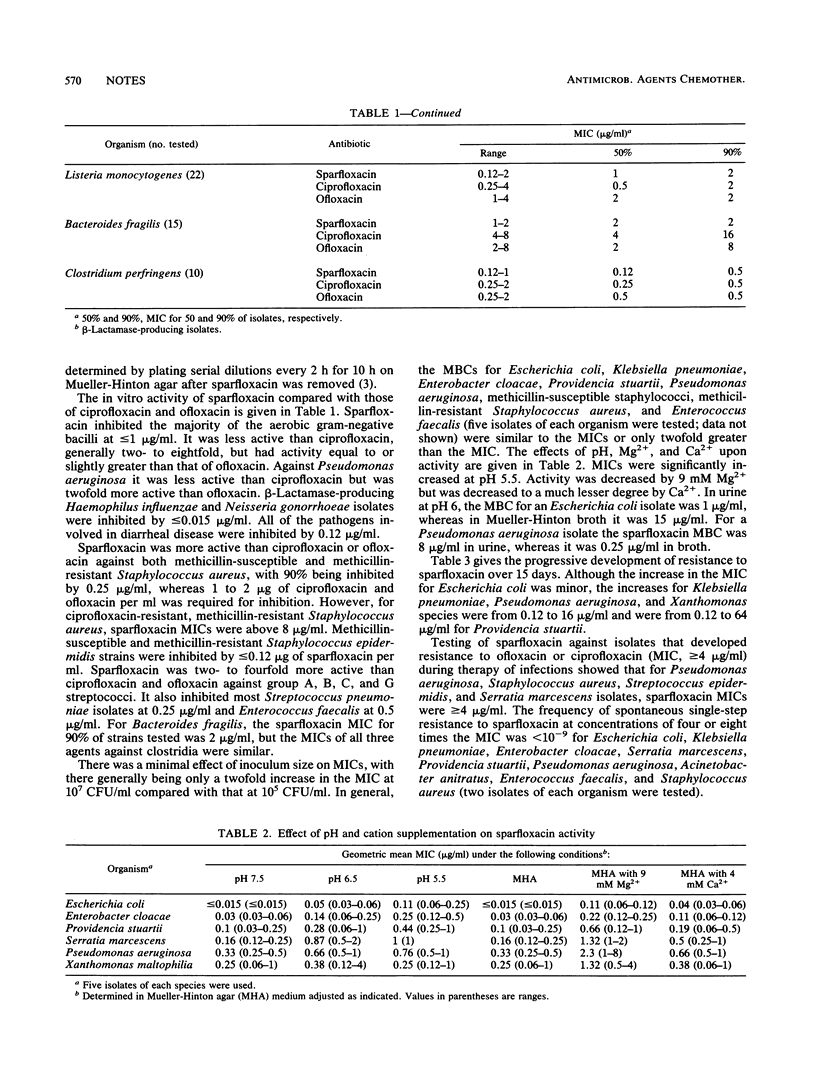Abstract
Sparfloxacin, a new fluoroquinolone, inhibited the majority of members of the family Enterobacteriaceae at less than or equal to 1 microgram/ml. It was less active than ciprofloxacin but more active than ofloxacin. Against Pseudomonas aeruginosa, it was less active than ciprofloxacin but twofold more active than ofloxacin. It inhibited Staphylococcus aureus and most Streptococcus pneumoniae and Streptococcus pyogenes isolates at 0.25 micrograms/ml, whereas ciprofloxacin and ofloxacin inhibited these isolates at 2 micrograms/ml. Bacteroides fragilis was inhibited by less than or equal to 2 micrograms/ml. Sparfloxacin was less active at an acidic pH and in the presence of Mg2+. Resistance to sparfloxacin was produced by repeated exposure, although the frequency of single-step mutants was less than 10(-9).
Full text
PDF




Selected References
These references are in PubMed. This may not be the complete list of references from this article.
- Chin N. X., Figueredo V. M., Novelli A., Neu H. C. In vitro activity of temafloxacin, a new difluoro quinolone antimicrobial agent. Eur J Clin Microbiol Infect Dis. 1988 Feb;7(1):58–63. doi: 10.1007/BF01962176. [DOI] [PubMed] [Google Scholar]
- Chin N. X., Neu H. C. Post-antibiotic suppressive effect of ciprofloxacin against gram-positive and gram-negative bacteria. Am J Med. 1987 Apr 27;82(4A):58–62. [PubMed] [Google Scholar]
- Espinoza A. M., Chin N. X., Novelli A., Neu H. C. Comparative in vitro activity of a new fluorinated 4-quinolone, T-3262 (A-60969). Antimicrob Agents Chemother. 1988 May;32(5):663–670. doi: 10.1128/aac.32.5.663. [DOI] [PMC free article] [PubMed] [Google Scholar]
- Hardy D. J., Swanson R. N., Hensey D. M., Ramer N. R., Bower R. R., Hanson C. W., Chu D. T., Fernandes P. B. Comparative antibacterial activities of temafloxacin hydrochloride (A-62254) and two reference fluoroquinolones. Antimicrob Agents Chemother. 1987 Nov;31(11):1768–1774. doi: 10.1128/aac.31.11.1768. [DOI] [PMC free article] [PubMed] [Google Scholar]
- Hirschhorn L., Neu H. C. Factors influencing the in vitro activity of two new aryl-fluoroquinolone antimicrobial agents, difloxacin (A-56619) and A-56620. Antimicrob Agents Chemother. 1986 Jul;30(1):143–146. doi: 10.1128/aac.30.1.143. [DOI] [PMC free article] [PubMed] [Google Scholar]
- Kojima T., Inoue M., Mitsuhashi S. In vitro activity of AT-4140 against clinical bacterial isolates. Antimicrob Agents Chemother. 1989 Nov;33(11):1980–1988. doi: 10.1128/aac.33.11.1980. [DOI] [PMC free article] [PubMed] [Google Scholar]
- Nakamura S., Minami A., Nakata K., Kurobe N., Kouno K., Sakaguchi Y., Kashimoto S., Yoshida H., Kojima T., Ohue T. In vitro and in vivo antibacterial activities of AT-4140, a new broad-spectrum quinolone. Antimicrob Agents Chemother. 1989 Aug;33(8):1167–1173. doi: 10.1128/aac.33.8.1167. [DOI] [PMC free article] [PubMed] [Google Scholar]
- Neu H. C., Novelli A., Chin N. X. Comparative in vitro activity of a new quinolone, AM-1091. Antimicrob Agents Chemother. 1989 Jul;33(7):1036–1041. doi: 10.1128/aac.33.7.1036. [DOI] [PMC free article] [PubMed] [Google Scholar]
- Pearson R. D., Steigbigel R. T., Davis H. T., Chapman S. W. Method of reliable determination of minimal lethal antibiotic concentrations. Antimicrob Agents Chemother. 1980 Nov;18(5):699–708. doi: 10.1128/aac.18.5.699. [DOI] [PMC free article] [PubMed] [Google Scholar]
- Sherman R. A. Central catheter infection: single-versus triple-lumen catheters. Am J Med. 1989 Jul;87(1):2–3. doi: 10.1016/s0002-9343(89)80469-3. [DOI] [PubMed] [Google Scholar]


